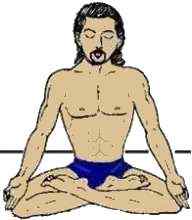| |
 |
apid |
Just what you need to know! |
| eview |
|

Basic Facts about the Yoga Posture (Asana)
The Lotus Posture (whose original Indian name is Padmasana or Kamalasana) in Yoga is very suitable for chanting mantras (Japa) and for meditation (Dhyana). Buddha is most frequently portrayed in this famous Lotus pose.
Note that Padma or Kamala means Lotus. The posture gets its name because the person performing it resembles a Lotus.
Stepwise Technique 
- Sit on the ground with your head and spine erect without drooping your shoulders. Extend your legs forward such that your knees and heels are placed together. With the help of your hands, place your right foot on the left thigh and then your left foot on the right thigh. Try to touch the knees to the ground and turn the soles of your feet upwards. Attempt also to minimize the gap between the left and right heels. See the Half Lotus Posture (Ardha Padmasana) for more details.
- Touch the thumb of each hand to the index finger at the tips to form a circle. Ensure that the other three fingers are straight. Rest your left hand on your left knee and your right hand on your right knee with the palms facing upwards. Keep your arms straight at the elbows. This hand position is called Jnana Mudra (Knowledge Hand Gesture) because it signifies the knowledge of connecting the Individual Soul (Atma) with the Supreme Soul (Paramatma).
- Remain in this final posture with your eyes closed for about 1-2 minutes (in the early stages) or your breakpoint*. Increase this time gradually to several minutes.
- Repeat the above steps with your left foot placed first on the right thigh and your right foot then placed on the left thigh. This will ensure that both legs are built uniformly.
Tips and Comments
- In Step 2, the hands were positioned in Jnana Mudra (Knowledge Hand Gesture). They may be alternatively positioned in Dhyana / Padma Mudra (Meditation / Lotus Hand Gesture) or Drona Mudra (Bowl Hand Gesture) as described below.
- Bend your arms at the elbows and place your hands below your navel on your lap. Keep the palms (a little cupped and with extended fingers) one on top of the other (usually, right palm on the left palm). The thumbs may either be straight or touch at the tips to form a triangle. This hand position is called Dhyana Mudra (Meditation Hand Gesture) because it is the hand posture recommended for meditation, or Padma Mudra (Lotus Hand Gesture) because it looks like the lotus petals.
- Rest your left palm on your left knee and your right palm on your right knee with the cupped palms facing downwards. Keep your arms straight at the elbows. This hand position is called Drona Mudra (Bowl Hand Gesture) because the palm is shaped like a bowl (Drona) covering your knees.
- In the early stages, you may experience pain in the knees and may be able to place only one foot comfortably on the thigh. Therefore, you may wish to try the Half Lotus Posture (Ardha Padmasana) as a preparatory exercise. Regular practice will make the process of placing both feet on the thighs easier. Beginners with rigid knees and/or ankles should proceed with care.
- Instead of keeping the eyes closed, you may focus on the nose tip (Nasagra Drishti) or between the eyebrows (Bhrumadhya Drishti).
- It is possible to remain in the Padmasana position for even a few hours. However, care must be exercised to check for discomfort during as well as after the asana.
- *Breakpoint is the time upto which you can comfortably remain in a yoga posture. It varies from individual to individual depending on one's fitness, age and will power.
Potential Benefits of the Yoga Posture (Asana)
- The Lotus Posture (Padmasana) helps reduce excess fat in the body especially in the abdominal region. It aids in better functioning of the digestive and excretory systems.
- The yoga posture assists in the cure of pain in the knees, ankles, and back. Its practice helps those suffering from insomnia and asthma.
- The yoga posture keeps the mind focused because it requires one to sit upright. It is a posture often suggested for practicing Breath Control (Pranayama), Concentration (Dharana), Meditation (Dhyana) and Self-realization (Samadhi).
Disclaimer : Syvum makes no representations or warranties of any kind, express or implied, as to the correctness of the content as well as the accuracy and use of the information regarding the practice of Yoga. It is strongly advised that you consult your physician before engaging in any physical activities. The information herein is not intended to substitute professional medical opinion or qualified Yoga instructors' opinion. To the full extent permissible by applicable law, Syvum disclaims all warranties, express or implied, including but not limited to, implied warranties and fitness for a particular purpose. Syvum will not be liable for any damages of any kind arising from the use of the information regarding the practice of Yoga, including but not limited to direct, indirect, incidental, punitive and consequential damages.
|
|

